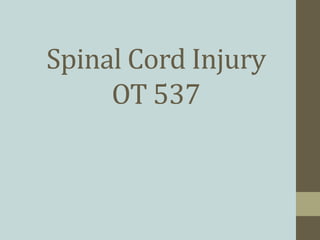This document provides an overview of spinal cord injury (SCI), including statistics, causes, classifications, complications, and systems affected. It discusses that there are approximately 12,000 new SCI cases per year in the US, with males more likely to sustain injury. SCI can be traumatic or non-traumatic, and is classified by level and completeness of injury. Common complications include respiratory issues, autonomic dysreflexia, skin breakdown, edema, DVT, and temperature regulation problems. Systems like bladder, bowel, sensation and motor function below the level of injury are impacted depending on the severity and level of the lesion.































